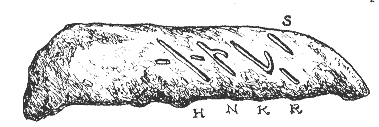One of the really intriguing things about your local Roman Catholic Church is that if you get your pastors' permission to do so, you can go up to the altar and lift up the altar cloth and you will see one or more small drill marks in the stone, plastered-over.
Why?
The reason for them is fascinating. Holes were drilled in the altar stone, and martyrs' relics pushed into them, and then they were sealed with plaster.
Why?
Because nearly 2,000 years ago, the Catholic Church was bathed in martyrs' blood in the time of its formation. Before the Roman Emperor Constantine fully legitimized the Church, the emperors, who did not like this emerging new sect, would authorize persecutions, to force members to publicly forswear their allegiance. Soldiers would be dispatched to the homes of those known to be followers of "Christus" and, like the Nazis of World War II going door-to-door hunting for hidden Jews, threaten loss of life and property if they did not say the right thing. Many were murdered in response. (I believe that this shall happen again, in the not-too-distant future.) Soldiers were shocked as men, women and children voluntarily stretched out their necks for execution. Nothing spread Christianity faster through the ranks of the Roman army than asking them to participate in hunts for Faithful followers of "Christus." Membership in the Church boomed.
Many of the martyrs were buried in the underground cemeteries on Rome and environs, called "catacombs." The faithful would sneak into the catacombs for Mass, which would frequently be held on top of the stone sarcophagi of the more prominent martyrs.
It was this practice -- consecration on top of the martyrs stone graves, an appropriate site since the body and blood of Christ at Mass is the body and blood of Christ sacrificed -- which gradually mutated into a rule requiring that martyrs' relics be place into altar stone assemblies.
At St. Martin of Tours Catholic Church on Oxford Circle in Philadelphia, where I went to Mass when I was a kid, they used to have a portable altar -- a rolling metal frame with a small stone slab on top for consecration, and a rack beneath for the metal reliquary box which held a saint's relics.
One of the more famous ancient stone structures in New England is the Newport Tower, in Newport, Rhode Island.
I have been to it. The local consensus is that it was a windmill belonging to Benedict Arnold's grandfather.
In fact, it is one of the most astonishing stone structures in the United States. It is the tower portion of a fortified Roman Catholic Church built in Newport by Roman Catholic Vikings around the year 1357. The public records dispatching the mission from the united kingdom of Sweden and Norway to "Vinland" -- the Viking name for America -- in 1354, almost 150 years before Columbus, have been located. The design of the Newport tower is the same as the design for fortified church towers in the joint kingdom of Sweden and Norway constructed around that time. The mortar between the stones is of the variety in use in that era. In the second story, there is a fireplace on the inside, with a chimney built into the wall -- a feature in Scandinavian construction during that era. On the outside of the building is a stone bearing the Norse runes for H-N-K-R-S ...
... meaning "hinikirs," the Norse term meaning "chair church," which is what "cathedral" actually means -- "church of the [bishop's] chair."
On the inside wall of the second story there is a slot in the stone wall for their altar stone for Roman Catholic Mass, and beneath that altar stone slot is a square niche for their reliquary box ...



No comments:
Post a Comment